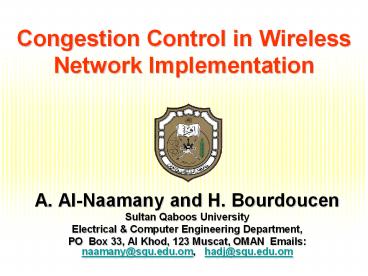Congestion Control in Wireless Network Implementation - PowerPoint PPT Presentation
Title:
Congestion Control in Wireless Network Implementation
Description:
Congestion Control in Wireless Network Implementation A. Al-Naamany and H. Bourdoucen Sultan Qaboos University Electrical & Computer Engineering Department, – PowerPoint PPT presentation
Number of Views:185
Avg rating:3.0/5.0
Title: Congestion Control in Wireless Network Implementation
1
Congestion Control in Wireless Network
Implementation
- A. Al-Naamany and H. Bourdoucen
- Sultan Qaboos University
- Electrical Computer Engineering Department,
- PO Box 33, Al Khod, 123 Muscat, OMAN Emails
naamany_at_squ.edu.om, hadj_at_squ.edu.om
2
Problem
- On going academic research being undertaken at
Sultan Qaboos University - Inspired by successful research at University of
California, Berkley - Initially started as Wired Network Congestion
Control
3
Problem
- The Internet and most current intranet networks
are experiencing a huge increase in the volume of
traffic. - This affects directly the network congestion by
saturating the buffers at the routers and
contributes to generating lots of data losses as
well as reception and transmission delays. - The existing TCP end-to-end congestion control
uses Additive Increase Multiplicative Decrease
(AIMD) approach, a time out and slow start
behavior, which lead to data throughput with
abrupt changes
4
Problem
5
Approach
- Therefore, developing new congestion control
strategies based on non-analytical approaches
will certainly help to overcome the current
difficulties of the internet in particular which
are due to - network structural complexity,
- diversity of services supported,
- variety of parameters involved.
- This research presents a fuzzy logic-based
approach for controlling the network congestion.
Its main objective - optimize the available bandwidth
- keep smooth the data throughput transfer profile
6
Transmission Rate
7
- Utilization of Fuzzy Logic
Fuzzy logic Controller
8
- Membership Functions of the Two Inputs
9
- De-Fuzzification
10
Effect of packet loss rate p and dp/dt on fuzzy
logic transmission rate
11
Effect of packet loss rate p and dp/dt on
transmission rate
12
Sending Rate approaching Actual Rate
13
Congestion Control for WLAN
- The AIMD is not entirely suitable for wireless ad
hoc networks - This is very evident in cases where networks
links are broken as a result of node mobility and
it takes time to perform route reconfiguration in
which cases data loss is assured - The data packets could be lost or hindered, where
, in TCP the sender can mistake this event as
congestion.
14
Congestion Control for WLAN
- A need for mechanism to distinguish packet drops
due broken links and route configuration - Have a quick start and high sending rate once
the new route is identify instead of additive
increase - Smoothly decrease the rate to the
actual/appropriate sending rate using Fuzzy logic
or other mechanism.
15
FL Congestion Control for WLAN
16
Conclusions
- TCP congestion controller can be developed to
offer to smooth the data throughput profile and
to optimize the network transfer bandwidth
including WLAN. - This can be achieved using a fuzzy logic
compensator, which identifies the transfer rate
steps depending on the packet drop rate and the
round trip time of the network at a given point
of time. - In addition, due to dynamic network constraints,
the proposed method allows proximity tracking of
both the bandwidth and data throughput profile.
This has been ensured by embedding within the
controller a damping function to avoid abrupt
changes of the transmission rate.
17
Conclusions
- This approach allows reducing unnecessary
over-transmitted packets that will be lost in the
network and at the same time reduces the abrupt
Changes. - Because of its non-analytical nature, the
proposed approach appears as a good candidate to
complement the available congestion controllers
for unicast as well as for multicast systems in
Wired and WLAN.































